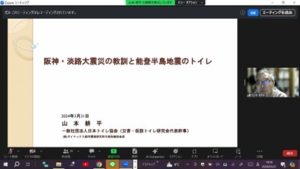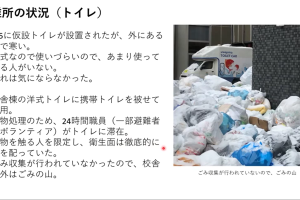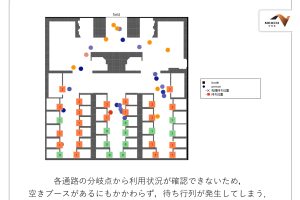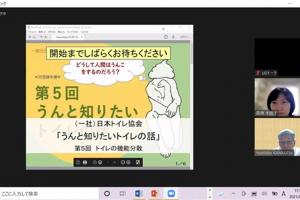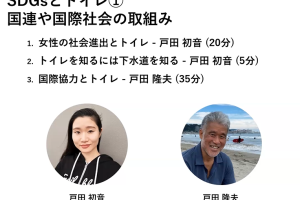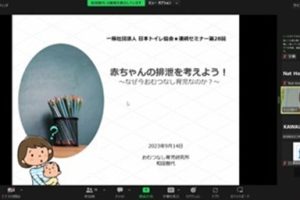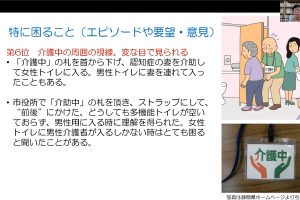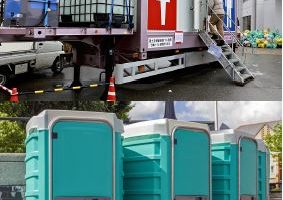The 33rd seminar
“Urgent Report part 2, Noto peninsula catastrophic earthquake on the new year day of 2024”
Japan Toilet Association (JTA) Seminar Series; “Let us know more about our Toilet Story”
Date: 21 March 2024 (Thu) 18:00-20:00 JST

Master of Ceremony (MC); Dr. Mikiko Takahashi (Director of JTA, Manager of R&D Division of Comany Inc.)
Presenters:
Lecturer/Reporter 1; Mr. Shizuho Ookuchi (Noto peninsula catastrophic earthquake victim, Visually Impaired)
“Toilets in the evacuation shelters from the perspective of the visually impaired people”
Lecturer/Reporter 2; Mr. Wataru Tanimoto (JTA Steering Committee Member, Deputy representative of the Disaster and Temporary Toilet Study Group in JTA, Manager of Sales Planning Dept. of Hino Kogyo Co., Ltd.)
“Current status and challenges for Noto peninsula catastrophic earthquake”
Lecturer 3; Mr. Kohei Yamamoto (JTA Steering Committee Member, Representative of the Disaster and Temporary Toilet Study Group in JTA, Chairman and Director of Dynax Urban Environment Research Institute Co., Ltd.)
“Lessons about toilets learned from Hanshin Awaji catastrophic earthquake and Noto peninsula catastrophic earthquake”
(Takahashi) 4,563 people evacuated to the temporary evacuation shelters at Noto peninsula catastrophic earthquake, 105 people evacuated to 1.5th stage evacuation shelters in Kanazawa city as of the 19 March. Then about 3,800 people evacuated to 2nd stage evacuation shelters. In total, 8,468 people still evacuated. In addition, there are many people who are still staying in the broken houses.
As for water, 11,460 households in Ishikawa prefecture are still out of the water service, and almost all Suzu city are totally without water service.
When I asked people in Suzu city what they needed right now, they told me that there were not enough the portable toilets. It seems that Suzu city government delivered one meal a day to the evacuation shelters, but only one meal a week was delivered in Nanao city, and residents are still having hard time on the toilet matters and food.

(1) “Toilets in evacuation shelters from the perspective of visually impaired people” (Lecturer: Mr. Shizuho Ookuchi)
(Takahashi) Mr. Oguchi lived in Suzu city where is the tip of Noto peninsula, was suffered the most damage by this Noto peninsula catastrophic earthquakes. He was affected there by the disaster and evacuated to the 1.5th stage evacuation shelter in Kanazawa city. Now he is evacuating at Kaga city, where is the southernmost area of Ishikawa prefecture.
(Ookuchi) I have visual impairment, and I can slightly recognize light or dark to some extent. I can hardly recognize people or objects. When the time of the earthquake occurred, it was New Year’s Day, and I was sleeping in my room at home in Suzu city. I have always kept the disaster evacuation kit nearby. I immediately grabbed it and escaped when the earthquake occurred. I had prepared the kit nearby, since the earthquakes have been occurring continuously for the past two to three years here in Ishikawa prefecture. I tried to go down the stairs, but the stairs were broken. They were littered with the crumbling walls, then I climbed down with sitting down posture with grabbing onto the handrail.
The evacuation drills have been held in Suzu city. When a Tsunami warning was alerted, my family and friends immediately fled to higher ground behind my house. The roads were liquefied by the earthquake and vehicles could not drive. Since I can’t see, my friend led me the steps and gave me directions to take a detour, and finally I could escape. There was a steep concrete-paved slope covered with the snow, and neighbours and friends pulled or pushed me to lead me the higher ground.
The evacuation shelter was my elementary school of the alma mater. The inside of the classroom was fully covered with the mattresses. There were no lanes between the mattresses, so it occasionally happened to step on other people. I had no choice but to rely fully on my family to get around due to my visual impairment.
The elementary school had a disaster prevention warehouse, where the portable toilets were stocked. The toilet bowls in the toilet were sitting style ones, which helped me. However, it was extremely difficult to put the coagulant in the bag, excrete into it, make it into small and the put it in an odour proof bag. I only had to ask my family help. Since my family was also affected and exhausted by the disaster, and the volunteers were also same condition. I felt it became difficult to ask them for my help.
Once I tried to do it myself, but since I am visually impaired, I had to touch the toilet with my hands. Due to the poor sanitary conditions, I happened to touch feces several times during 12-day primary evacuation. I think the reason for this problem was that many of them were elderly, and they didn’t know how to use it or found it troublesome. Then, everyone gradually started to dislike using them since the usages of the portable toilets were different by the manufacturers. As a result, people used it without setting them up properly, and resulted in the piles of the excrement left in the toilet bowl.
Even if the portable toilet manufacturers are different, I think the usage must be standardized as possible. When I happened to touch other’s excrement, I wiped it off with a wet tissue, rub my hands repeatedly with a dry paper, and then apply rubbing alcohol to my hands by the water outage.
(Takahashi) When I went to Wajima for the first time on 7th and 8th January, I wore a diaper because I could not know the local toilet condition. I drank just a little water to moisten my mouth. I almost could not eat since I was so worried about going to the toilet. Although it was only for two days, I felt a strong desire to wash my hands with the water, drink gulps of water, and eat a full meal.
(Ookuchi) I felt gradually anxious about asking my family and people around me for my help. I tend to think negatively, like not drinking water or not eating. My priority was to reduce the journeys to the toilet. I was fortunately able to go home during the day time, and there I washed my hands in the river near the house.
There were many people at the evacuation shelter who were sick. I also felt sick, probably because I had been infected to the virus by touching the excrements. I lost my appetite, had vomiting, and got diarrhea. I knew I must drink water to prevent the dehydration. However, when I do, I have to instantly go to the toilet. I had such a worst experience for a few days.
I was truly glad that the temporary toilets finally installed there. Although they were the crouching style ones, it had equipped the water flushing system and clean. Then I ended up using only them. To use the temporary toilet, my family guided me since they were installed the outside the school building cross the schoolyard.
I had to ask things to my family help every time which normally I could do by myself in my home. I truly regrated to ask it as my family was also tired. The toilet matter was a most serious problem after the earthquake damage.
The portable toilets were overwhelmingly insufficient. The instructions for use were different by the manufacturers. Even a user who initially tried to follow the instructions but gradually felt it tedious and became neglect. The handy toilets should be produced by the unified standard.

(2) “Current status and challenges for Noto peninsula catastrophic Earthquake”
(Lecturer: Mr. Wataru Tanimoto)
Hino Kogyo Co., Ltd., where I work, is a founding manufacturer of a temporary toilets in Japan. As a company, we have been involved in all large-scale disasters in Japan since Hanshin Awaji catastrophic earthquake in1995. I have also overseen all disasters since Kumamoto catastrophic earthquake in 2016. There are often installed the temporary toilets at event venues. There are also an increasing number of the temporary toilets and comfortable toilets for the particularly women use.
There are also some toilets for people with disabilities. We, both as Hino Kogyo company and as a member of JTA have been involved in various disaster prevention awareness activities. According to the Ministry of Land, Infrastructure, Transport and Tourism, immediately after the disaster, the earthquake victims will use the handy toilets or portable toilets for at least three days, and after that, the manhole toilets stockpiled in various places and the temporary toilets can be used gradually.
However, the handy toilets have been used long time at the recent Noto peninsula catastrophic earthquake. It was difficult to contact everyone involved including our own staff since the earthquakes occurred on just New Year’s Day and almost all employees were on the new year vacation. The government has placed a large-scale rental order for them as pull-type support since the temporary toilets are not included in the eight items of push-type support stipulated by the government. The provided temporary toilets were mostly crouching style toilets, but we added attachments and modified them to sitting style ones.
We brought the antifreeze into the cleaning solution and prepared insect and deodorant, since the earthquake occurred in the cold region in winter. A battery-powered sensor light was set at night and a disinfectant cleaner for the toilet seat.
We created a manual for on-site installation method. We also created a troubleshooting and Q&A manual when a problem occurs with the temporary toilet, so that users could deal with it without an expert. The locations of the temporary toilets were recorded on the online map to support the management. I heard that this information was also shared with Ministry of the Environment via the Ministry of Economy, Trade and Industry, and was also useful when pumping toilets.
The transporting the temporary toilets was far more difficult than the other disasters, as the roads were severely damaged and it was snow and bad weather, making it dangerous and difficult to transport. Because the roads were narrow, the efficient transportation by the large lorries was not possible. Night work was too dangerous, so working hours were limited. Some sites were difficult to install, such as on top of stairs or on soft ground.
I think it would be easier our works if the installation location had been discussed and decided in advance about pumping, installation, security issues, etc. It took a long time because only land transportation was possible due to the depopulated and disaster-affected areas. There was also the fear of secondary disasters caused by the continuous earthquakes. There were some places that were passable on the way arriving at a destination but not on the way back.
It was difficult to connect timely with the local staffs due to the communication environment problems. Information routes were not unified and it was unprecise from the local staff. This situation made us sometimes be reworked.
At first, the employees were motivated to help the disaster community. After many information about local road conditions and weather came in from the media, not only employees but also their families began to worry about how much our private company could do. It was difficult for me to decide as there were widespread voices of concern.
In addition to the traditional temporary toilets, next-generation toilets have also supplied. They were a completely self-contained toilet such as that does not require electricity but only need to be filled with water, a mobile toilet of the trailer house, and a toilet car that was integrated onto lorries. These days, the local governments keep toilets and some are lent to the residents. At this time, our company did not ship the toilets to be used by the wheelchairs. I think the main reason is that there are almost no wheelchair accessible toilets in stock on the market, rather than there is less request from the local community.
During the initial stage, the temporary toilets were normally kept in stock for use at the construction sites and delivered from the rental companies near the disaster area. Therefore, crouching style toilets were the main ones. However, January and February were low seasons for the construction work, and the rental companies had much temporary toilets in stock. If this earthquake had happened in the summer, I think the supply would have been extremely difficult.
Last year, we, the Disaster and Temporary Toilet Study Group in JTA, surveyed on the ratio between the sitting style and crouching style temporary toilets. The rental companies own only 33.9% of sitting style ones of the simple flush toilets. The sitting style toilet is common in most household and public toilets nowadays. Currently the numbers of the temporary toilets of the sitting style are quite little. The percentage of new sitting style toilets shipped by the temporary toilet manufacturers is still 37.3%. Even the newly shipment of the crouching style toilets are still sold well in the field of the temporary toilets. The sitting style toilets are popular at many events. Whereas our company delivers about 97% of the rentals to the construction sites. It is particularly high ratio in the housing industry.
The budget constraints are severe in the small-scale housing construction sites and the crouching style toilets with low-quality are still overwhelmingly in demand. There is only one wheelchair-accessible toilet out of every 1,000 temporary toilets. I think this is almost nothing when considering the rental rate of it. We cannot expect much change in the private rental industry for the spread of the sitting style toilets, we believe that the national and local governments should well consider about keeping toilets to meet the demand from the disaster areas. In addition, when considering rapid response to disaster areas, it is necessary to respond quickly by the push-type support. I think it is essential to collaborate with related parties and utilize ICT etc. regarding the sparce of information.

(3) “Lessons about toilets learned from Hanshin Awaji catastrophic earthquake and from Noto peninsula catastrophic earthquake”
(Lecturer: Mr. Kohei Yamamoto)
(Yamamoto) I would like to consider about the differences of the toilet situations between Hanshin Awaji catastrophic earthquake and recent Noto peninsula catastrophic earthquake. Hanshin Awaji catastrophic earthquake happened on 17 January, 1995. There were many deaths and injuries because it was happened in a large city with many populations. At that time, I was working as a volunteer in Kobe city. I feel that the situation at the time was like Noto peninsula catastrophic earthquake, such as the situation at the evacuation shelters and the remains of the fire.
When I was in Kobe at Hanshin-Awaji catastrophic earthquake, the disaster victims couldn’t do anything but dug holes in the ground and used the garbage bags since the portable toilets like today were not yet commonly used. The garbage bags in Kobe city at the time were coloured black or blue and the contents could not be observed. People used to defecate by lining the bags with newspaper or filling with the pet sand. Digging a hole is extremely difficult in the cities. Even if someone digs a hole manually, it must be just a shallow hole.
I saw that toilets had been built over the manholes with the fences, when I was walking around Kobe city. Afterwards, we proposed this to Kobe city, and we built the manhole toilets in the elementary schools on a trial basis during the reconstruction period. I think that this experience probably led to the various products such as the handy toilets becoming popular. The most effective option immediately after a disaster is to use a manhole toilet, but I heard that no preparations were made for this in Noto peninsula catastrophic earthquake.
The newly developed manhole toilets started to install at Kumamoto catastrophic earthquake in 2016. The handy toilets were very useful at Noto peninsula catastrophic earthquake. They are push-type support and delivered spontaneously. However, it is unclear whether supply and demand were well matched. I think this needs to investigate in detail later.
I think the most problem with Noto peninsula catastrophic earthquake is how to dispose of the used handy toilets. I heard that the excrement in garbage bags got mixed in with the common garbage and making it extremely difficult to collect at Hanshin Awaji catastrophic Earthquake. It exploded in the garbage lorries and some workers were covered in them. The excrement and common garbage must be separated and collect differently. I have heard that in some evacuation shelters in Noto, the garbage was not separated. I think this is most important issue to be careful.
At Hanshin Awaji catastrophic earthquake, it was difficult to know where to procure the temporary toilets, and they were sent from various places and set all over the place without any planning, and it was difficult to know where and how many were there eventually. There gathered many evacuees at one evacuation shelter as it was a large populated area. There was an overwhelming lack of toilets. About one temporary toilet was installed for every 100 people in two weeks after the disaster, and the complaints decreased. The number of the evacuees decreased later and became to be about one for every 70 people.
Currently, there are standards for the international humanitarian aid, such as the Sphere Standard, and the cabinet office indicates the numbers such as one in 50 people, or one in 20 people for the long term use. It will be necessary to verify what happened in this earthquake. The temporary toilets at the evacuation shelter toilets were located outdoors and might be quite far from its entrance. From the point of view of the installer, if it is not decided on the location from the beginning by considering the flow line, we cannot install them toilets after they are already shipped. This needs to be planned well before a disaster occurs. Comparing photos of the temporary toilets, the appearances look the same today as they were 30 years ago. The facilities inside may be a bit better, but in general, the temporary toilets have not made much progress. There is a tank under it. Then the floors are set in the high position and there are steps. This makes difficult for the elderly people who use these toilets for several times a day.
Additionally, there was an extreme shortage of sitting style toilets and some elderly people to refrain from defecating. There have also been cases of elderly people harming their health by refrain from drinking water. A similar problem was pointed out at Noto peninsula catastrophic earthquake. Therefore, it makes sense that people tend to use the portable toilets rather than temporary toilets.
This time, the comfort improved that the trailer-type or on-board toilets were provided in some places. I think the number is small, but as awareness and needs for these toilets increase, more local governments may start to keep them. I think it is necessary to accurate the number and usage situation.
The work to clean temporary toilets did not go smoothly during Hanshin Awaji catastrophic earthquake. The locations of the temporary toilets were not well indicated. There was also an overwhelming shortage of the vacuum cleaning lorries. The toilet cleaning tools were not included in the disaster relief supplies. Then JTA raised money and sent the gloves and deck brushes.
I have heard that there were surprisingly less problems with pumping in Noto catastrophic earthquake, but I wonder what is the reality. At Hanshin Awaji catastrophic earthquake, the sewage treatment plants were seriously damaged and the disposal of the gathered excrement became a serious problem. Whereas in Noto peninsula catastrophic earthquake, the sewage treatment plant seems to have damaged relatively little.
The wheelchair accessible toilets were extremely scarce at Hanshin Awaji catastrophic earthquake. There was no accessible evacuation shelter. I heard many wheelchair users had to go to the hospitals or the welfare facilities to use the accessible toilets, or tried various efforts on the spot.
Noto had a system in place for the welfare evacuation shelter, but I heard that many were unable to open. I also heard about the trailer toilets being placed at welfare centres. I think it is necessary to observe the effects and problems of this matter.
The volunteers are required to cover their own expenses, sleeping, and eating, but they cannot afford by themselves of using the toilet. Many volunteers gathered at the Hanshin Awaji catastrophic earthquake and I presume they used the toilets at the evacuation shelter as well. However, at East Japan catastrophic earthquake in 2011, they were asked to prohibit using the toilets at the evacuation shelters. Even in areas affected by floods and other disasters, many volunteers were ordered not to use the toilets at the evacuation shelters. They must return to the volunteer centres to use them. However, this would shorten the total volunteer time only to go back to the toilet. It is necessary to consider the toilets for the volunteers.
We surveyed the actual situations of the toilets at Hanshin Awaji catastrophic earthquake. The results were compiled, published, held symposiums, presented at the academic conferences, and published in a book. These became the basis for data on how many temporary toilets were needed.
I think it is necessary to verify the actual situation of toilets in Noto peninsula catastrophic earthquake as well. We propose that such as a study group may be called “Research Group on the Actual Situation and Challenges of Toilets in Noto peninsula catastrophic earthquake.” This is to be organized with JTA, the national government, local governments, academic experts, and disaster victims to gather information.
We conducted a survey of the local governments across Japan in 2019. It was found that not many local governments had plans for the toilets at a disaster. 35% of local governments had no plan. I think it is quite necessary to make toilet plan underling the policy in advance. Toilets are basically a human right. It cannot be ignored it against the excuses of a disaster. I think it is necessary to clarify this philosophy.
【Q&A】
(Q1: Yamamoto) How did the requests for shipping the temporary toilets reach to your company this time? How were the maintenance, pumping, and treatment processed after the installation?
(A1.1: Tanimoto) Very soon after a disaster happened, I received a message from Ministry of Economy, Trade and Industry via either email or phone asking us to prepare to ship. Although it is not a formal request yet, we received a message asking us to start preparations by noon on 2nd January. Then, we rushed to prepare. However, we have not yet received any specific details about how many units we must send and where is the destination.
(A1.2: Tanimoto) In the meantime, we were constantly receiving the inquiries from our regular customers about deliveries for the common use. However, we put on hold them as a disaster priority. In a large-scale disaster, the rule is that a request from the national government is the top priority. Ministry of Economy, Trade and Industry is basically a pull-type support that responds to local requests. It has decided to ship about 500 temporary toilets to Kanazawa first, since we cannot wait this time. There was a delay in the transportation from Kanazawa to the various evacuation shelters in the disaster areas. The local governments were in a state of confusion, and they were difficult to send their requests for the temporary toilets.
The system for the collecting defecation inevitably was delayed. Information where the evacuation shelters had the temporary toilets was also obscured. There existed a lot of random non-public evacuation shelters. Some temporary toilets were suddenly delivered from somewhere.
Particularly this time, there were much more small-scale evacuation shelters than I presumed. It was quite difficult to catch the situation because the roads were severely cut off, and many of the areas were aging society and the inhabitants could not evacuate far away. Then the temporary toilets were placed in nearby locations, such as one per village, and so on. This was a true situation happened.
The nicest thing was that I heard that Ministry of the Environment is collecting their precise data, and gradually the vacuum cleaning lorries from the outside to the prefecture have gathered, then the things improved gradually.
In other words, the way of thinking has not changed from 30 years ago, and both people and governments cared to the food first, and tended to neglect the preparation of the toilets.
(Q2: HA) I would like to hear more about how different types of the portable toilets to be difficult to use.
(A2.1: Ookuchi) The first portable toilet I used had a double-layered the bag type. Put a coagulant in it. After defecating, tied it up, put it in another bag, and then put it in an odour-proof bag.
The second one was one single bag type. Filled it with two types of the coagulant, tied it up after use, and put it in an odour-proof bag.
The third one was too complicated. It had strings at the four corners of the bag, and tied them to the toilet seat to defecate, then tied the strings and put a coagulant inside the bag.
(A2.2: Tanimoto) Actually, it should be made much simpler to use. The usage standards are not well unified.
(C3: Yamamoto) The portable toilets should be separated from the daily garbage. However, it is difficult to distinguish between the portable toilet bags and daily garbage. I think the bags for the portable toilets should be coloured identically or wrapped with special coloured tape so that they can be distinguished from other garbage.
This also needs to be discussed from the point of the improvement of the standards. I think that Disaster/Temporary Toilet Research Group in JTA will consider and discuss such issues.
We simply assume that each person uses five portable toilets a day, and most disaster victims use them over a period of several days, it will end up being a huge amount of the garbage. As I am an environmental consultant, I have been creating disaster waste treatment plans. However, until now, the garbage of the portable toilets has not been included in the plan.
(Q4: TO) Please tell us about the difficulties of the installing and managing the temporary toilets in the summer.
(A4: Tanimoto) In the summer, the biggest problem is how to solve with the insects and odours problems. However, if the chemicals are too strong, the temporary toilet itself may be damaged. Therefore, instead of killing insects, we use the insect repellents. However, it is still not widely recognized, and it must be difficult to obtain it at the affected location.
According to our survey in summer, when it is 30 degrees outside, the inside the temporary toilets must reach about 35 degrees Celsius. We installed the air conditioning in high-quality toilets, but it is not possible to install it in the common ones due to the space and budget constraints.
(Q5: HO) For people with the visual impairments, it may be effective to install something that makes a sound, such as a bell for the toilet equipment? Also, it may be easier to use the portable toilets with Braille or symbols attached on?
(A5: Oguchi) When I opened the entrance door to the wheelchair-accessible toilet at the 1.5th evacuation shelter, a voice guidance explained the usages. However, there was only an explanation at the entrance, it was difficult to remember all. Not many people read Braille even if they are visually impaired. There are several AP’s that can read information on the smartphone. However, they cannot be used without the internet connection.
(C5: KAG) There are also systems that can be used offline if downloaded them in advance.
(Q6: KAU) Why the proportion of the sitting style toilets does not increase among the temporary toilet procurement?
(A6: Tanimoto) The constructions order by the government requires sitting style toilets and the budget is including. However, the proportion of the construction orders from the government is not many and they are mostly from the private sites. The temporary toilet rental fees are being targeted for the cost reduction due to rising materials and labour costs. The rental fees of the sitting style toilets are more expensive than the crouching ones. We receive orders from the sites with the tight budgets. The crouching style toilets can be rented cheaply, so more and more this style toilets are manufactured. The reason is not from the needs but from the budget reason.
(Takahashi) Even though it has been nearly three months passed after the catastrophic earthquake occurred, some affected areas in Noto still have troubles finding toilets and food. We, JTA would like to continue to seriously regard about this earthquake issues and the solutions.
